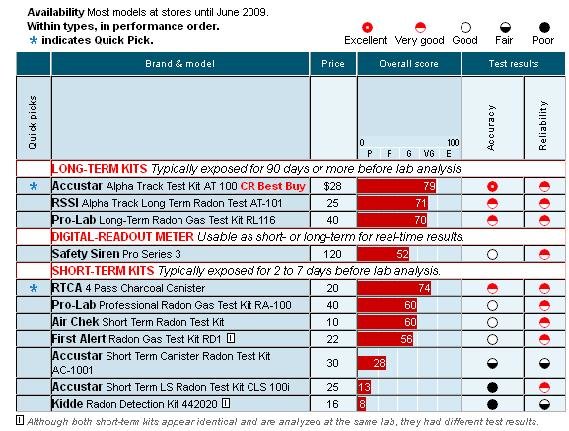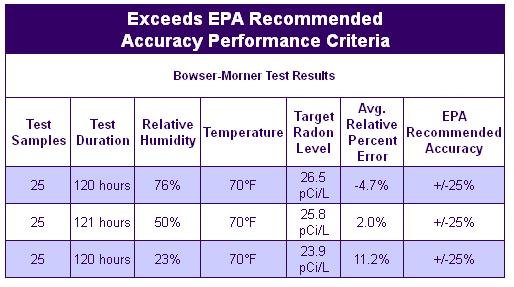Hej
Finns här någon som har erfarenhet av Radon Gas Detector Pro
Eller finns andra förslag på radonmätare, har sett R2, men för dyr.
http://www.safehomeproducts.com/shp...-siren/radon-monitor-and-alarm/1449/1449.aspx
Finns här någon som har erfarenhet av Radon Gas Detector Pro
Eller finns andra förslag på radonmätare, har sett R2, men för dyr.
http://www.safehomeproducts.com/shp...-siren/radon-monitor-and-alarm/1449/1449.aspx
Jag gjorde en tremånaders mätning i vintras, mätte ett av gästrummen, hade ingen ventilation öppen, fick resultatet 340bq, vill nu testa och se vad resultatet blir med bra ventilation. Vill även mäta fler rum i källaren då jag funderar på att flytta ner våra sovrum i källaren.
Det bör gå bra med vilken mätare som helst.
Fördelen med RDG Pro-3 är ju priset. Nackdelarna: Du måste beställa från
USA (räkna med moms+tull också). Mätaren visar inte i Bq utan i PiCu men
det löses med omräkningsfaktor. Slutligen så måste du skaffa en Svensk nätdel till den också. Sen är det bara att köra!
Har du kollat förekomst av radonhaltigt byggnadsmaterial?
Fördelen med RDG Pro-3 är ju priset. Nackdelarna: Du måste beställa från
USA (räkna med moms+tull också). Mätaren visar inte i Bq utan i PiCu men
det löses med omräkningsfaktor. Slutligen så måste du skaffa en Svensk nätdel till den också. Sen är det bara att köra!
Har du kollat förekomst av radonhaltigt byggnadsmaterial?
Hur Safety siren står sig mot lite olika amerikanska spårfilmsdosor.

En kille som plockat isär sin Safety Siren Radon Detector och visar mätvärden i realtid på sin sida.
http://www.howmuchsnow.com/arduino/radon/
Noggrannheten testad på en Safety Siren Radon Gas Detector.


Inloggade ser högupplösta bilder
Logga in
Skapa konto
Gratis och tar endast 30 sekunder
En kille som plockat isär sin Safety Siren Radon Detector och visar mätvärden i realtid på sin sida.
http://www.howmuchsnow.com/arduino/radon/
Noggrannheten testad på en Safety Siren Radon Gas Detector.

Inloggade ser högupplösta bilder
Logga in
Skapa konto
Gratis och tar endast 30 sekunder
How does this radon gas detection process work?
When the Po-219 decays by alpha emission, 50% of the alphas will be emitted into the detector junction where it forms a pulse of charge and is counted. The other 50% go undetected. In either case, the Po-218 decay product, Pb-214, will stay attached to the detector. The Pb-214 decays by beta emission to Bi-214. The beta is an electron with varying amounts of energy, depending on how the beta decay process shared its energy with a neutrino. But this is not important since the beta has a much lower LET (Linear Energy Transfer) than an alpha. This is a technical way of saying that the beta does not ionize the detector junction nearly as much as the alpha. The radon monitor has a threshold for the alpha energy to be counted; the beta is below this threshold.
So, the Pb-214 decays to Bi-214 by beta decay (~27 minutes) and the Bi-214 decays to Po-214 by beta (~20 minutes), putting the process back to a Polonium isotope. Now the Po-214 decays by alpha emission, 50% of which are detected just like the Po-218. This goes quickly, Po-214 half life is ~0.00016 seconds. At this point, we have counted about one alpha for every Rn-222 atom that diffused into the chamber, assuming that they all stay in the chamber. (This makes no difference if they diffuse out before decaying because others will diffuse in, establishing equilibrium.)
The Po-214 alpha decay forms a Pb-210 isotope. This is also a beta emitter, but its half life is ~22 years. However, it will accumulate on the detector and will be the source of background counting due to exposure to Rn-222. The more that accumulates, the higher the decay rate (disintegrations per unit time) will become. WhenPb-210 decays by beta, it forms Bi-210, which also decays by beta with a half life of 5 days, much faster that the Pb-210. From the Bi-210 decay we get Po-210, sounds familiar. The Po-210 will decay by alpha with a half life of about 138 days, and 50% of these decays will be counted which contributes to the background of the radon monitor. Since the 22 years is such a long time, this is not a serious problem, unless deployment of the monitor changes from a high concentration (for a long time) to a low concentration. As a rule of thumb, for every year a monitor sees an average concentration C, then the background will be about 1% of that average concentration. For example, if a radon monitor was deployed in a building for 5 years with an average concentration of 20 pCi/l, then the background counting rate would contribute about 1 pCi/l. (5*20*1% = 1)
When the Po-219 decays by alpha emission, 50% of the alphas will be emitted into the detector junction where it forms a pulse of charge and is counted. The other 50% go undetected. In either case, the Po-218 decay product, Pb-214, will stay attached to the detector. The Pb-214 decays by beta emission to Bi-214. The beta is an electron with varying amounts of energy, depending on how the beta decay process shared its energy with a neutrino. But this is not important since the beta has a much lower LET (Linear Energy Transfer) than an alpha. This is a technical way of saying that the beta does not ionize the detector junction nearly as much as the alpha. The radon monitor has a threshold for the alpha energy to be counted; the beta is below this threshold.
So, the Pb-214 decays to Bi-214 by beta decay (~27 minutes) and the Bi-214 decays to Po-214 by beta (~20 minutes), putting the process back to a Polonium isotope. Now the Po-214 decays by alpha emission, 50% of which are detected just like the Po-218. This goes quickly, Po-214 half life is ~0.00016 seconds. At this point, we have counted about one alpha for every Rn-222 atom that diffused into the chamber, assuming that they all stay in the chamber. (This makes no difference if they diffuse out before decaying because others will diffuse in, establishing equilibrium.)
The Po-214 alpha decay forms a Pb-210 isotope. This is also a beta emitter, but its half life is ~22 years. However, it will accumulate on the detector and will be the source of background counting due to exposure to Rn-222. The more that accumulates, the higher the decay rate (disintegrations per unit time) will become. WhenPb-210 decays by beta, it forms Bi-210, which also decays by beta with a half life of 5 days, much faster that the Pb-210. From the Bi-210 decay we get Po-210, sounds familiar. The Po-210 will decay by alpha with a half life of about 138 days, and 50% of these decays will be counted which contributes to the background of the radon monitor. Since the 22 years is such a long time, this is not a serious problem, unless deployment of the monitor changes from a high concentration (for a long time) to a low concentration. As a rule of thumb, for every year a monitor sees an average concentration C, then the background will be about 1% of that average concentration. For example, if a radon monitor was deployed in a building for 5 years with an average concentration of 20 pCi/l, then the background counting rate would contribute about 1 pCi/l. (5*20*1% = 1)
Hittade även pdf dokumentet med testet på Safety Siren Radon Gas Detector:
http://inspectusa.com/electron_detectors/Bowser-MornerTestResults2004.pdf
http://testproducts.com/electron_detectors/Bowser-MornerTestResults2004.pdf
http://inspectusa.com/electron_detectors/Bowser-MornerTestResults2004.pdf
http://testproducts.com/electron_detectors/Bowser-MornerTestResults2004.pdf
Liknande trådar
-
Högt radon pga blåbetong - firma FTX-ventilation?
Ventilation -
Radonduk och regnvatten - ett problem!?
Grund & Markarbeten -
Radon från mark - lämplig åtgärd? 250bq/m
Miljö & Hälsa -
Radon i potentiellt hus - HUR TUSAN LÖSER MAN DET?
Miljö & Hälsa -
Radonsanera skrubb - fulventilera med typ Paxfläkt?!
Miljö & Hälsa
